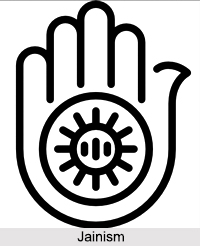 Jainism divides mankind into a caste system which is further divided into numerous sub-castes (Jatis). All sorts of beings belong to Jainism, but it does not mean that they are equal in their status. All Jivas are divided into four levels of existence; Gods, human beings, animals and beings in hell. Each one of them has a number of classes which are precisely distinguished from one another, and the individual classes are further divided into sub-classes. The uppermost three castes are called "twice-born" because their males experience a second, spiritual birth by a special consecration in which they are encircled by a holy thread. The castes of Brahmins or the priests, Kshatriyas or the warriors and Vaishyas or the businessmen are the "twice-born".
Jainism divides mankind into a caste system which is further divided into numerous sub-castes (Jatis). All sorts of beings belong to Jainism, but it does not mean that they are equal in their status. All Jivas are divided into four levels of existence; Gods, human beings, animals and beings in hell. Each one of them has a number of classes which are precisely distinguished from one another, and the individual classes are further divided into sub-classes. The uppermost three castes are called "twice-born" because their males experience a second, spiritual birth by a special consecration in which they are encircled by a holy thread. The castes of Brahmins or the priests, Kshatriyas or the warriors and Vaishyas or the businessmen are the "twice-born".
An important aspect of caste system among the Jains is that the followers of the Jain religion are compelled to marry the members of the other religious communities because their all-powerful code of the caste does not permit them to marry a person from their own community, but coming from a different caste.
History of Caste System in Jainism
In the first, lucky eras of the world-period all men were equal. According to Jain tradition, Adinath was first person, who initiated the people into various arts and crafts and to establish social institutions like Marriage, Family, Class, Education, etc. He also introduced social customs, manners and religious practices. He organized society into four folds and showed the path of liberation, which was then, followed by the rest 23 Tirthankaras. The division into castes were only three castes at the beginning. They were;
i. Kshatriyas, who were supposed to protect humanity with the help of the weapons,
ii. Vaishyas, who were to look after trade, agriculture and cattle-breeding and
iii. Sudras, whose duty it was to do all sorts of works.
Caste System experienced further development under Bharata. Bharata had founded the Brahmana caste among the Jains.
The four Varnas appear to be originally ranks and belonging to them was conditioned more by profession than by birth. Even the social respect given to the different castes was a different one among the Jains in the old period.
Modern Caste System in Jainism
In 6th century BC, Lord Mahavira, the last Jina, rejected the authority of Vedas, the religious beliefs and practices of Vedic society. He welcomed all the castes and gave privilege to perform religious rites. The focus of Sramana tradition was rigorous asceticism, as the name suggests. He had a large congregation of different castes and classes. This tradition was carried forward later on by Acharyas. As Acharya Ravisena asserts that, "it is not the birth but activities that determine one`s class in the society. The actions alone lead to good prosperity".
The caste of today form fixed organized bodies which regulate the private life of their members by their precepts on marriage, food and avoidance of ritual impurity and this is done to the smallest detail. A special body called the Panchayat watches over the strict implementation of the cast-laws and offences against the caste-order are punished by it.
It is certain that in the older historical periods of Jainism there was no such division of the society, as it is now, into a countless number of "Jatis" which cannot eat with one another nor marry among one another. Efforts are being made presently by the enlightened Jains to break the rigid barriers of the caste system.









